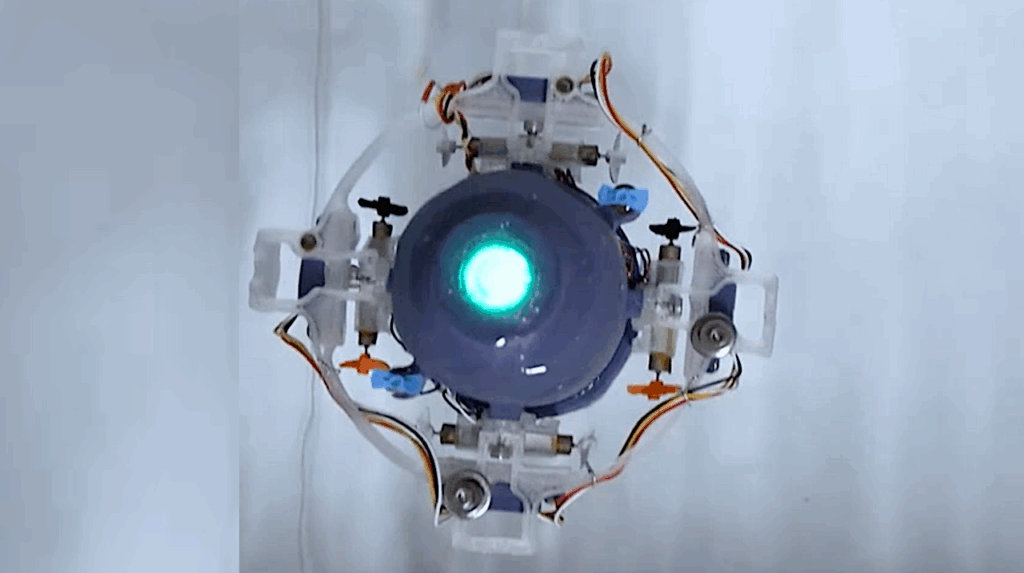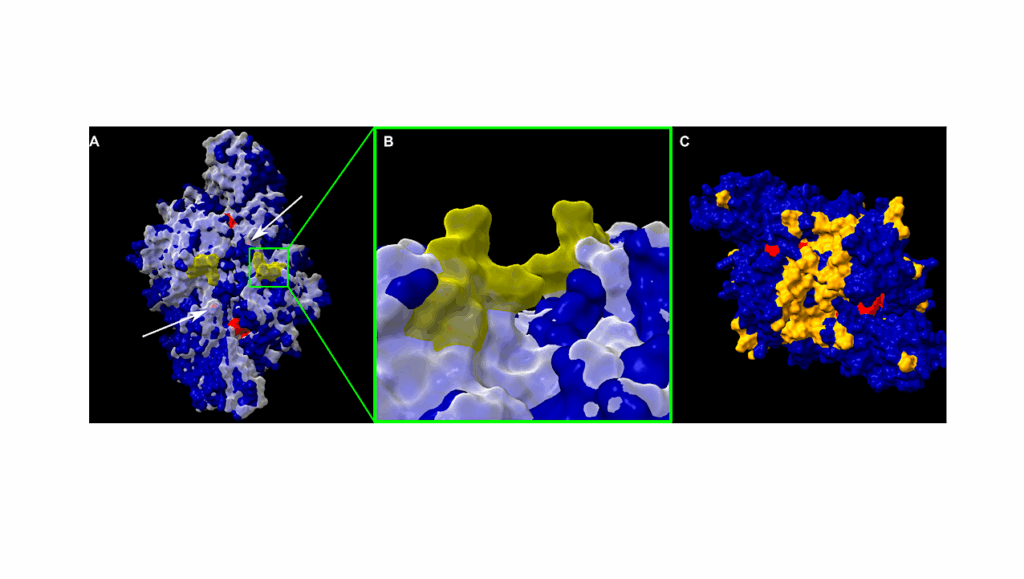During Snowball Earth Early Life May Have Sheltered In Meltwater Ponds
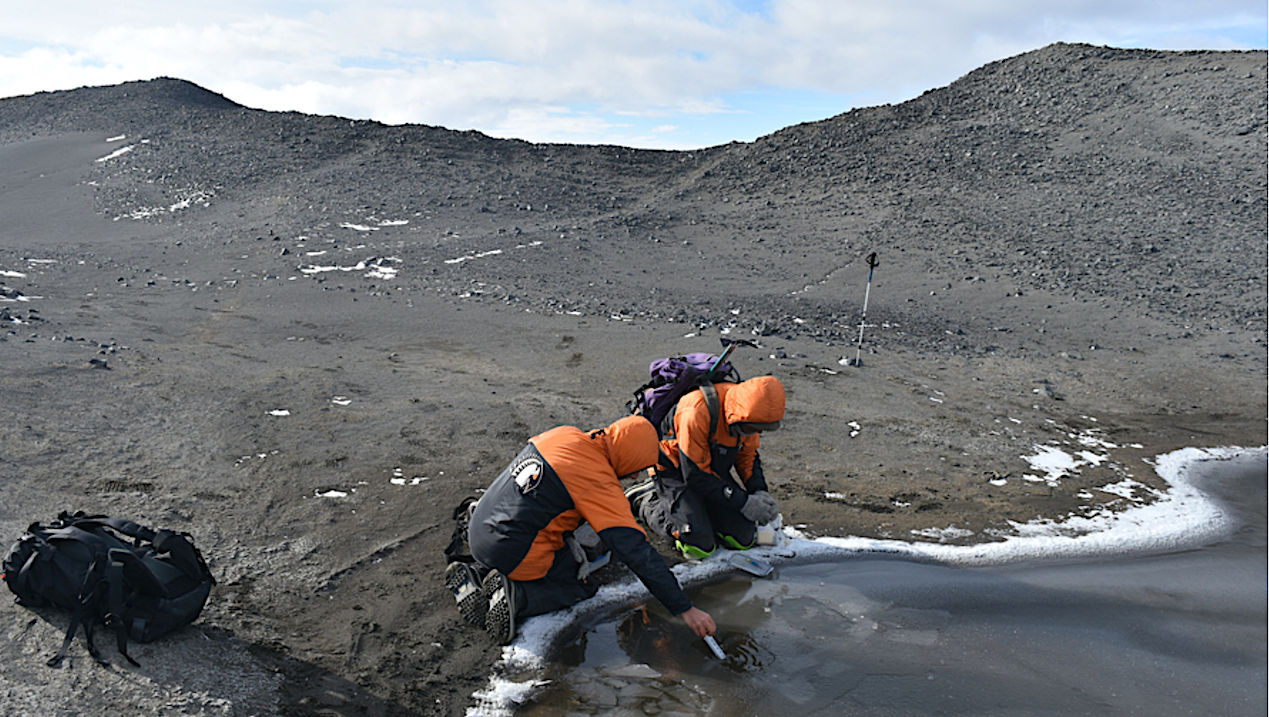
When the Earth froze over, where did life shelter? MIT scientists say one refuge may have been pools of melted ice that dotted the planet’s icy surface.
In a study appearing today in Nature Communications, the researchers report that 635 million to 720 million years ago, during periods known as “Snowball Earth,” when much of the planet was covered in ice, some of our ancient cellular ancestors could have waited things out in meltwater ponds.
The scientists found that eukaryotes — complex cellular lifeforms that eventually evolved into the diverse multicellular life we see today — could have survived the global freeze by living in shallow pools of water. These small, watery oases may have persisted atop relatively shallow ice sheets present in equatorial regions.
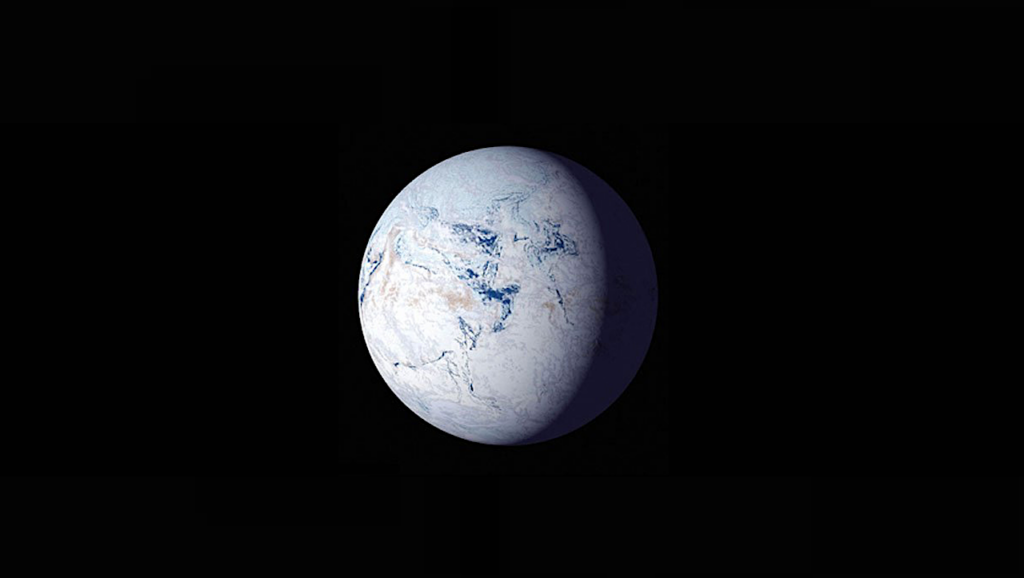
There, the ice surface could accumulate dark-colored dust and debris from below, which enhanced its ability to melt into pools. At temperatures hovering around 0 degrees Celsius, the resulting meltwater ponds could have served as habitable environments for certain forms of early complex life.
The team drew its conclusions based on an analysis of modern-day meltwater ponds. Today in Antarctica, small pools of melted ice can be found along the margins of ice sheets. The conditions along these polar ice sheets are similar to what likely existed along ice sheets near the equator during Snowball Earth.
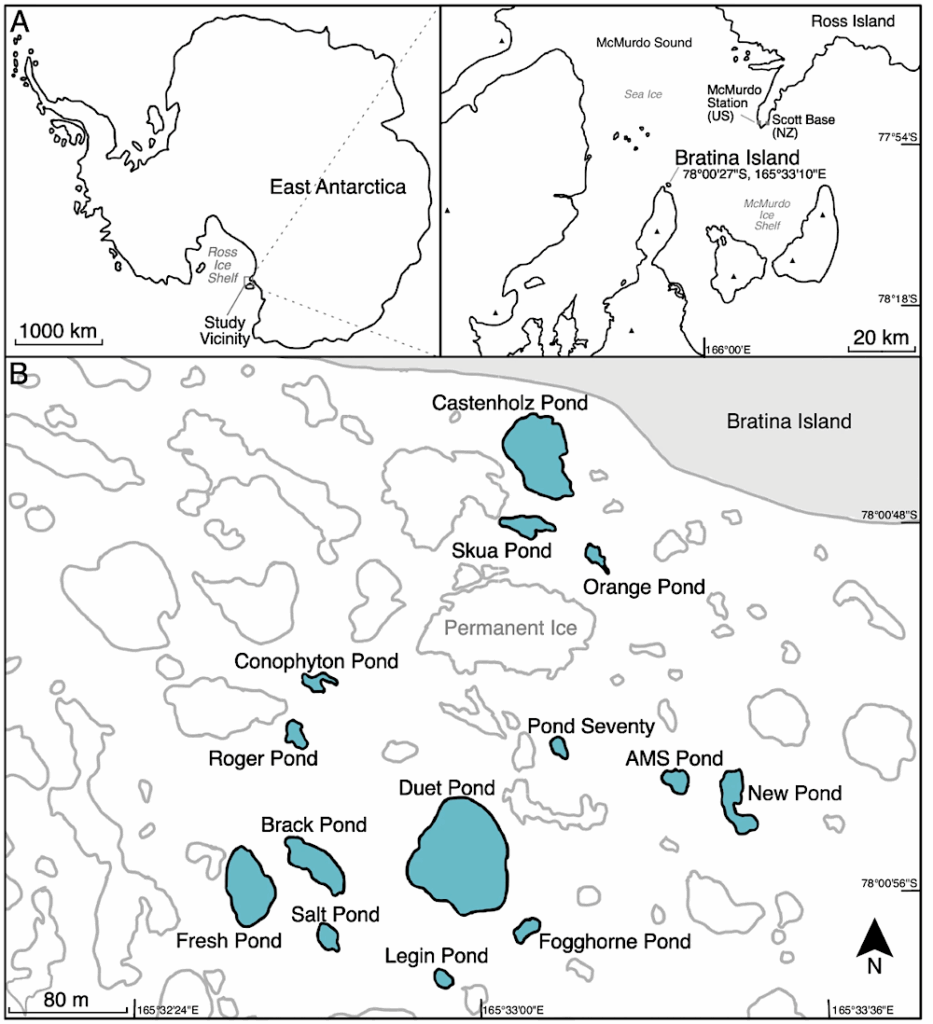
A The geographical location of the study vicinity and Bratina Island. B Detailed depiction of the meltwater ponds off the coast of Bratina Island based on satellite imagery. Sites included in this study are outlined in black and coloured in blue. Not shown: Bratina Lagoon, located approximately 1 km west of the area depicted. — Nature Communications
The researchers analyzed samples from a variety of meltwater ponds located on the McMurdo Ice Shelf in an area that was first described by members of Robert Falcon Scott’s 1903 expedition as “dirty ice.” The MIT researchers discovered clear signatures of eukaryotic life in every pond.
The communities of eukaryotes varied from pond to pond, revealing a surprising diversity of life across the setting. The team also found that salinity plays a key role in the kind of life a pond can host: Ponds that were more brackish or salty had more similar eukaryotic communities, which differed from those in ponds with fresher waters.
“We’ve shown that meltwater ponds are valid candidates for where early eukaryotes could have sheltered during these planet-wide glaciation events,” says lead author Fatima Husain, a graduate student in MIT’s Department of Earth, Atmospheric and Planetary Sciences (EAPS). “This shows us that diversity is present and possible in these sorts of settings. It’s really a story of life’s resilience.”
Polar plunge
“Snowball Earth” is the colloquial term for periods of time in Earth history during which the planet iced over. It is often used as a reference to the two consecutive, multi-million-year glaciation events which took place during the Cryogenian Period, which geologists refer to as the time between 635 and 720 million years ago.
Whether the Earth was more of a hardened snowball or a softer “slushball” is still up for debate. But scientists are certain of one thing: Most of the planet was plunged into a deep freeze, with average global temperatures of minus 50 degrees Celsius. The question has been: How and where did life survive?
“We’re interested in understanding the foundations of complex life on Earth. We see evidence for eukaryotes before and after the Cryogenian in the fossil record, but we largely lack direct evidence of where they may have lived during,” Husain says. “The great part of this mystery is, we know life survived. We’re just trying to understand how and where.”
There are a number of ideas for where organisms could have sheltered during Snowball Earth, including in certain patches of the open ocean (if such environments existed), in and around deep-sea hydrothermal vents, and under ice sheets. In considering meltwater ponds, Husain and her colleagues pursued the hypothesis that surface ice meltwaters may also have been capable of supporting early eukaryotic life at the time.
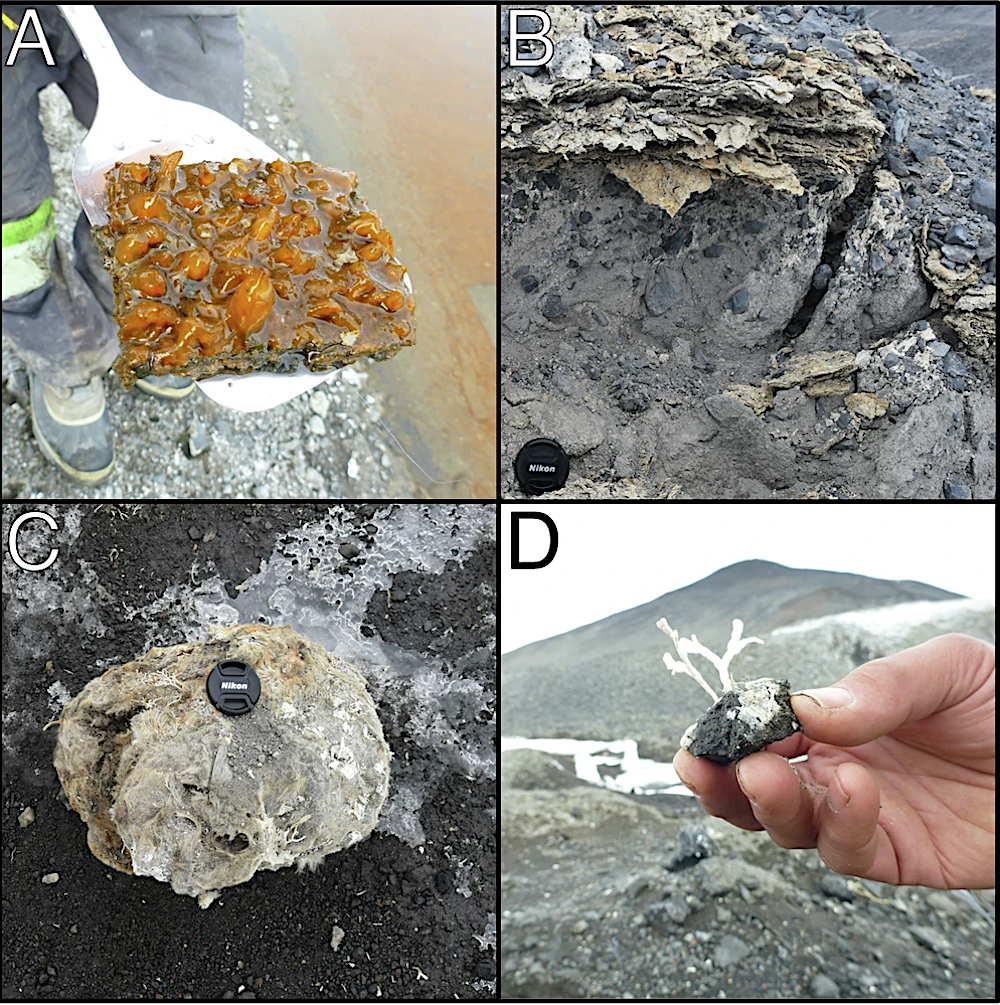
A Pustular microbial mat section collected from New Pond. B A mound of relict microbial mats. C A fossil sponge on the landscape surface atop pinnacle ice. D A fossil bryozoan. All photos were captured by RES in January 2018. — Nature Communications
The study’s MIT co-authors include Schlumberger Professor of Geobiology Roger Summons and former postdoc Thomas Evans, along with Jasmin Millar of Cardiff University, Anne Jungblut at the Natural History Museum in London, and Ian Hawes of the University of Waikato in New Zealand.
“There are many hypotheses for where life could have survived and sheltered during the Cryogenian, but we don’t have excellent analogs for all of them,” Husain notes. “Above-ice meltwater ponds occur on Earth today and are accessible, giving us the opportunity to really focus in on the eukaryotes which live in these environments.”
Small pond, big life
For their new study, the researchers analyzed samples taken from meltwater ponds in Antarctica. In 2018, Summons and colleagues from New Zealand traveled to a region of the McMurdo Ice Shelf in East Antarctica, known to host small ponds of melted ice, each just a few feet deep and a few meters wide. There, water freezes all the way to the seafloor, in the process trapping dark-colored sediments and marine organisms. Wind-driven loss of ice from the surface creates a sort of conveyer belt that brings this trapped debris to the surface over time, where it absorbs the sun’s warmth, causing ice to melt, while surrounding debris-free ice reflects incoming sunlight, resulting in the formation of shallow meltwater ponds.
The bottom of each pond is lined with mats of microbes that have built up over years to form layers of sticky cellular communities.
“These mats can be a few centimeters thick, colorful, and they can be very clearly layered,” Husain says.
These microbial mats are made up of cyanobacteria, prokaryotic, single-celled photosynthetic organisms that lack a cell nucleus or other organelles. While these ancient microbes are known to survive within some of the the harshest environments on Earth including meltwater ponds, the researchers wanted to know whether eukaryotes — complex organisms that evolved a cell nucleus and other membrane bound organelles — could also weather similarly challenging circumstances. Answering this question would take more than a microscope, as the defining characteristics of the microscopic eukaryotes present among the microbial mats are too subtle to distinguish by eye.
To characterize the eukaryotes, the team analyzed the mats for specific lipids they make called sterols, as well as genetic components called ribosomal ribonucleic acid (rRNA), both of which can be used to identify organisms with varying degrees of specificity. These two independent sets of analyses provided complementary fingerprints for certain eukaryotic groups.
As part of the team’s lipid research, they found many sterols and rRNA genes closely associated with specific types of algae, protists, and microscopic animals among the microbial mats. The researchers were able to assess the types and relative abundance of lipids and rRNA genes from pond to pond, and found the ponds hosted a surprising diversity of eukaryotic life.
“No two ponds were alike,” Husain says. “There are repeating casts of characters, but they’re present in different abundances. And we found diverse assemblages of eukaryotes from all the major groups in all the ponds studied. These eukaryotes are the descendants of the eukaryotes that survived the Snowball Earth. This really highlights that meltwater ponds during Snowball Earth could have served as above-ice oases that nurtured the eukaryotic life that enabled the diversification and proliferation of complex life — including us — later on.”
This research was supported, in part, by the NASA Exobiology Program, the Simons Collaboration on the Origins of Life, and a MISTI grant from MIT-New Zealand.
Biosignatures of diverse eukaryotic life from a Snowball Earth analogue environment in Antarctica, Nature Communications (open access)
Astrobiology


